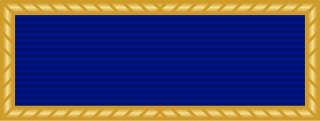
The Silver Star Medal (SSM) is the United States Armed Forces' third-highest military decoration for valor in combat. The Silver Star Medal is awarded primarily to members of the United States Armed Forces for gallantry in action against an enemy of the United States.

The Distinguished Flying Cross (DFC) is a military decoration of the United States Armed Forces. The medal was established on July 2, 1926, and is currently awarded to any persons who, after April 6, 1917, distinguish themselves by single acts of heroism or extraordinary achievement while participating in aerial flight. Both heroism and extraordinary achievement are entirely distinctive, involving operations that are not routine. The medal may be awarded to friendly foreign military members in ranks equivalent to U.S. Pay Grade of O-6 and below, in combat in support operations.

The Navy Cross is the United States Naval Service's second-highest military decoration awarded for Sailors and Marines who distinguish themselves for extraordinary heroism in combat with an armed enemy force. The medal is equivalent to the Army's Distinguished Service Cross, the Air and Space Forces' Air Force Cross, and the Coast Guard Cross.

The Distinguished Service Cross (DSC) is the United States Army's second highest military decoration for soldiers who display extraordinary heroism in combat with an armed enemy force. Actions that merit the Distinguished Service Cross must be of such a high degree that they are above those required for all other U.S. combat decorations, but which do not meet the criteria for the Medal of Honor. The Army Distinguished Service Cross is equivalent to the Naval Services' Navy Cross, the Air and Space Forces' Air Force Cross, and the Coast Guard Cross. Prior to the creation of the Air Force Cross in 1960, airmen were awarded the Distinguished Service Cross.

The Navy Distinguished Service Medal is a military decoration of the United States Navy and United States Marine Corps which was first created in 1919 and is presented to sailors and marines to recognize distinguished and exceptionally meritorious service to the United States while serving in a duty or position of great responsibility.
Chief Warrant officer is a senior warrant officer rank, used in many countries.
The Citation Star was a Department of War personal valor decoration issued as a ribbon device which was first established by the United States Congress on July 9, 1918. When awarded, a 3⁄16-inch (4.8 mm) silver star was placed on the suspension ribbon and service ribbon of the World War I Victory Medal to denote a Citation (certificate) for "Gallantry In Action" was awarded to a soldier, or to a marine or attached to the Army's Second Division, American Expeditionary Forces. The Citation Star was replaced in 1932 with the introduction of the Silver Star Medal.
The Awards and decorations of the United States Department of the Navy are the military awards and decorations which are presented to members of the United States Navy and United States Marine Corps under the authority of the Secretary of the Navy.
Awards and decorations of the Vietnam War were military decorations which were bestowed by the major warring parties that participated in the Vietnam War. North Vietnam, South Vietnam, Australia, New Zealand and the United States all issued awards and decorations to their personnel during, or after, the conflict.

The Presidential Unit Citation (PUC), originally called the Distinguished Unit Citation, is awarded to units of the uniformed services of the United States, and those of allied countries, for extraordinary heroism in action against an armed enemy on or after 7 December 1941. The unit must display such gallantry, determination, and esprit de corps in accomplishing its mission under extremely difficult and hazardous conditions so as to set it apart from and above other units participating in the same campaign.

The Medal of Valor is the Armed Forces of the Philippines' highest military honor awarded for a conspicuous deed of personal bravery or self-sacrifice above and beyond the call of duty that distinguishes the recipient from his comrades. It is defined in the Philippine Army Awards and Decorations reference material FC 1–0062, itself adapted from the Armed Forces of the Philippines Awards and Decorations Handbook, Second Edition published in 1997, as an award for "heroism in combat" and is foremost in the order of precedence of awards and decorations of the Armed Forces of the Philippines.
The War Cross for Military Valor is an Italian order for military valor. Established in 1922, the cross may be awarded only in time of war.
The Medal of Military Valor is an Italian medal, originally established as a Sardinian award. It is awarded to military personnel, units above the level of company, and civilians for exceptional valor in the face of the enemy.
The Gallantry Cross or Cross of Gallantry may refer to one of several military decorations:

The Medal of Honor (MOH) is the United States Armed Forces' highest military decoration and is awarded to recognize American soldiers, sailors, marines, airmen, guardians, and coast guardsmen who have distinguished themselves by acts of valor. The medal is normally awarded by the President of the United States and is presented "in the name of the United States Congress." It is often, not strictly correctly, referred to as the Congressional Medal of Honor.

William Pinckney was a United States Navy sailor who was the second African American to be awarded the Navy Cross, the second-highest decoration for valor in combat after the Medal of Honor. Pinckney received the medal for saving the life of a fellow crew member on board the USS Enterprise (CV-6) during the Battle of the Santa Cruz Islands. The Arleigh Burke-class destroyer USS Pinckney is named in his honor.
This page is based on this
Wikipedia article Text is available under the
CC BY-SA 4.0 license; additional terms may apply.
Images, videos and audio are available under their respective licenses.








